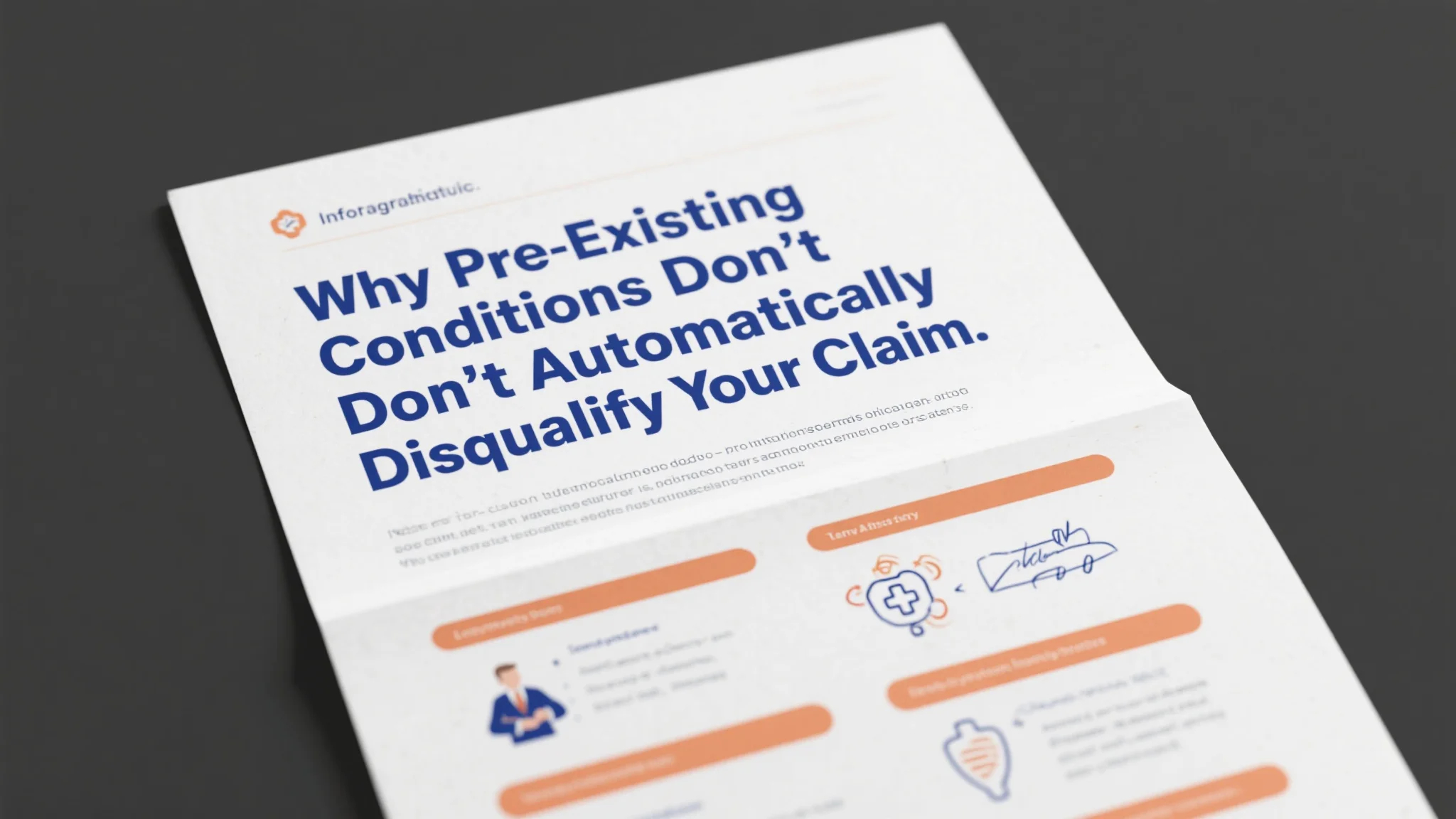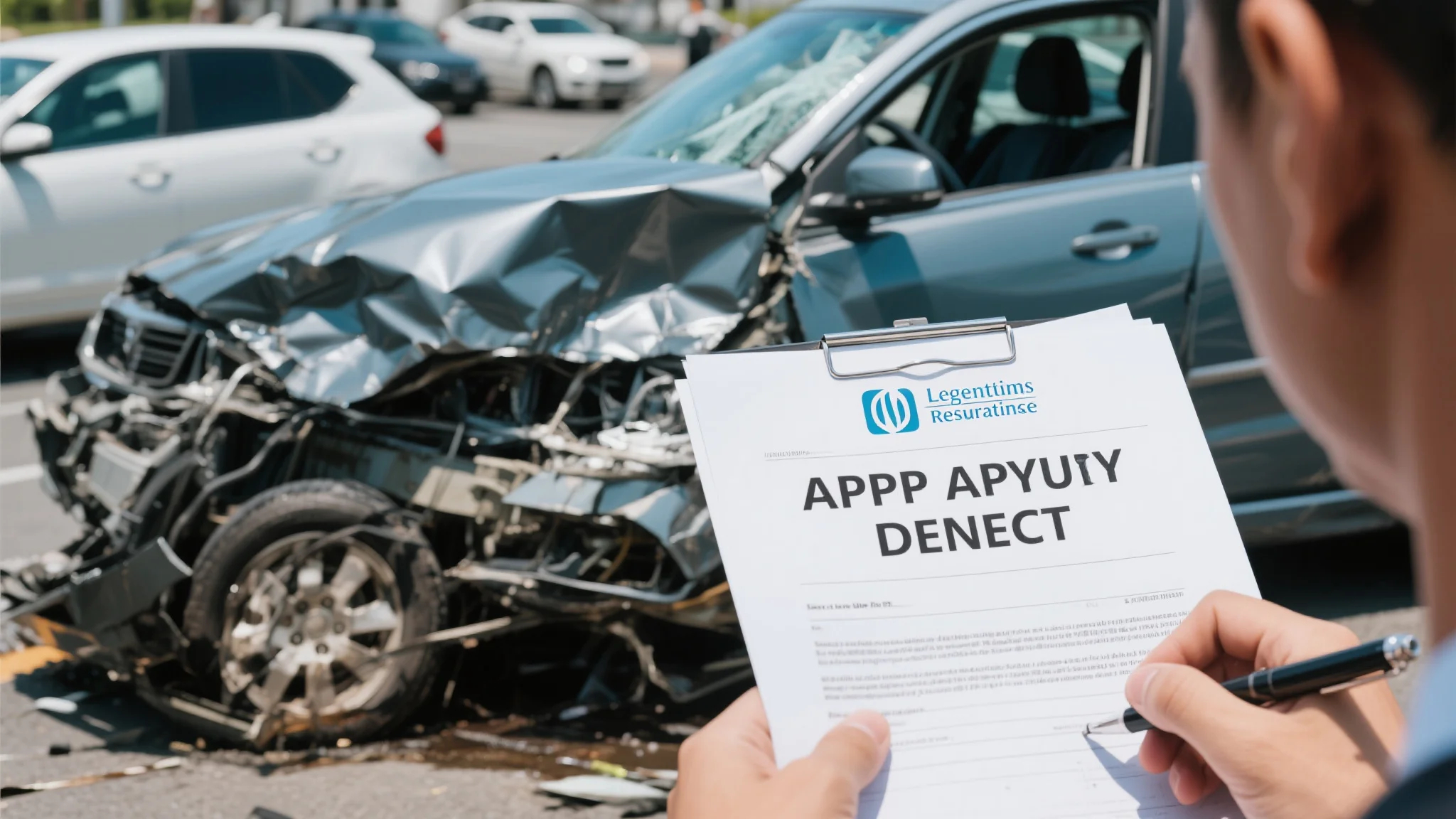Understanding How Pre-Existing Conditions Are Evaluated in Insurance Claims
One of the most persistent myths in the insurance industry is that having a pre-existing medical condition automatically disqualifies you from receiving compensation for new injuries sustained in an accident. This misconception has led countless accident victims to abandon legitimate claims or accept inadequate settlements, believing their medical history makes their case hopeless. However, experienced attorneys understand that pre-existing condition claim cases can be successfully pursued when the proper legal strategies are employed and the distinction between pre-existing conditions and accident-related injuries is clearly established.
The reality of how insurance companies handle pre-existing conditions is far more nuanced than many people realize. While it’s true that insurance companies will scrutinize claims more carefully when pre-existing conditions are present, the existence of such conditions does not automatically void your right to compensation for new injuries or the aggravation of existing conditions. The key lies in understanding how insurance adjusters and medical professionals differentiate between symptoms and limitations that existed before the accident and those that developed or worsened as a direct result of the incident in question.
Insurance companies often use the presence of pre-existing conditions as a strategy to minimize or deny claims, but this approach is not always legally sound. The law recognizes that individuals with pre-existing conditions have the same right to compensation for new injuries as those without such conditions. What matters is not whether you had a medical condition before the accident, but whether the accident caused new injuries or made your existing condition worse. This principle, known as the “eggshell skull” rule in legal circles, holds that defendants must take victims as they find them, including any pre-existing vulnerabilities or conditions.
The documentation and medical evidence required to successfully pursue an insurance claim pre-existing condition cases requires meticulous attention to detail and comprehensive medical record analysis. Your attorney will need to obtain complete medical records from before the accident to establish a baseline of your pre-existing condition’s severity and limitations. This baseline documentation becomes crucial for demonstrating how the accident changed your medical status, either by causing entirely new injuries or by significantly worsening your pre-existing condition beyond its previous level of impairment.
The timing of medical treatment following an accident plays a critical role in establishing the connection between the incident and any worsening of pre-existing conditions. Insurance companies often argue that any increase in symptoms or limitations is simply the natural progression of the pre-existing condition rather than a result of the accident. To counter this argument, it’s essential to seek immediate medical attention after an accident, even if you believe your injuries are minor or related to pre-existing conditions. Prompt medical evaluation creates a clear timeline that can help distinguish between pre-existing symptoms and new or worsened conditions resulting from the accident.
Medical professionals who treat patients with pre-existing conditions after accidents must be particularly thorough in their documentation and assessment. They need to carefully evaluate how the patient’s condition has changed since the accident, noting any new symptoms, increased pain levels, reduced functionality, or additional limitations that weren’t present before the incident. This detailed medical documentation becomes the foundation for proving that the accident caused compensable harm, even in the presence of pre-existing conditions.
The psychological impact of dealing with insurance companies when you have pre-existing conditions cannot be understated. Many accident victims feel defensive or embarrassed about their medical history, leading them to downplay their injuries or avoid seeking necessary treatment. This reaction is counterproductive and can actually harm their claim. Insurance companies may interpret gaps in treatment or reluctance to seek medical care as evidence that the accident didn’t cause significant harm. It’s important to understand that having pre-existing conditions doesn’t make you a less deserving victim, and you should pursue all necessary medical treatment without hesitation.
Legal Strategies for Protecting Your Rights Despite Medical History
Developing effective legal strategies for cases involving pre-existing conditions requires a deep understanding of both medical and legal principles, which is why seeking experienced attorney claim advice is crucial for protecting your rights and maximizing your compensation. Attorneys who specialize in personal injury cases involving pre-existing conditions know how to navigate the complex medical and legal landscape to build compelling cases that overcome insurance company resistance and skepticism.
One of the most important strategies involves working with medical experts who can provide clear, professional opinions about the relationship between your pre-existing condition and the injuries sustained in the accident. These medical experts must be able to distinguish between the limitations and symptoms that existed before the accident and those that developed or worsened afterward. The expert’s analysis should include a detailed review of your medical history, examination of your current condition, and a professional opinion about how the accident affected your pre-existing condition.
The selection of appropriate medical experts is crucial for the success of your case. Different types of accidents and injuries require different medical specialties, and your attorney should choose experts who have specific experience with your type of pre-existing condition and the injuries you sustained in the accident. For example, if you have a pre-existing back condition and were injured in a car accident, your attorney might work with orthopedic surgeons, neurologists, or pain management specialists who can provide authoritative opinions about how the accident affected your spinal condition.
Documentation strategies for pre-existing condition cases must be comprehensive and forward-thinking. Your attorney will need to gather not only your medical records but also employment records, activity logs, witness statements, and any other evidence that can demonstrate your functional capacity before and after the accident. This might include testimony from family members, friends, or coworkers who can describe how your condition and capabilities changed following the accident. The goal is to paint a complete picture of your life before and after the incident, showing clearly how the accident impacted your pre-existing condition.
The legal concept of apportionment becomes particularly important in pre-existing condition cases. Apportionment refers to the process of determining what percentage of your current condition and limitations can be attributed to the accident versus your pre-existing condition. While insurance companies often try to attribute all symptoms and limitations to pre-existing conditions, experienced attorneys know how to argue for fair apportionment that recognizes the accident’s contribution to your current medical status. This process requires sophisticated medical and legal analysis, but it can result in significant compensation even when pre-existing conditions are present.
Negotiation strategies for pre-existing condition cases require a different approach than typical personal injury claims. Insurance adjusters are often more skeptical and may require more extensive documentation and evidence to reach fair settlements. Your attorney must be prepared to present compelling medical evidence, expert testimony, and comprehensive documentation that clearly demonstrates how the accident affected your pre-existing condition. This might involve multiple rounds of negotiation, additional medical evaluations, or the threat of litigation to achieve a fair resolution.
The timing of settlement negotiations can be particularly important in pre-existing condition cases. Unlike cases involving only new injuries, pre-existing condition cases may require longer observation periods to fully understand how the accident affected your medical status. Your attorney may recommend waiting until your condition has stabilized or until you’ve reached maximum medical improvement before entering serious settlement negotiations. This patience can be crucial for ensuring that your settlement adequately compensates you for all accident-related changes to your condition.
Litigation strategies for pre-existing condition cases must address the unique challenges these cases present in court. Juries may be skeptical of claims involving pre-existing conditions, so your attorney must be prepared to educate the jury about the legal principles that protect your rights regardless of your medical history. This education process might involve expert testimony, demonstrative evidence, and clear explanations of how the law applies to your specific situation. The goal is to help the jury understand that having a pre-existing condition doesn’t diminish your right to compensation for accident-related harm.

Maximizing Compensation Through Proper Case Development and Presentation
The process of maximizing compensation in cases involving pre-existing conditions requires sophisticated case development techniques that go far beyond simply documenting the accident and resulting injuries. Successful attorneys understand that these cases demand a comprehensive approach that addresses every aspect of how the accident affected the client’s life, from immediate medical consequences to long-term functional limitations and quality of life impacts. This comprehensive approach is essential for overcoming insurance company resistance and achieving fair compensation that reflects the true extent of accident-related harm.
Economic damage calculations in pre-existing condition cases present unique challenges that require careful analysis and expert testimony. While it might seem straightforward to calculate lost wages and medical expenses, pre-existing conditions can complicate these calculations significantly. For example, if you had a pre-existing back condition that occasionally caused you to miss work, but the accident made your condition much worse and now causes you to miss work regularly, determining the accident’s economic impact requires sophisticated analysis. Your attorney must work with economic experts who can separate pre-accident economic losses from post-accident losses, ensuring that you’re compensated only for the additional economic harm caused by the accident.
Medical expense documentation in pre-existing condition cases requires particular attention to causation and apportionment. Insurance companies will scrutinize every medical bill to determine whether treatment was related to your pre-existing condition or to new injuries from the accident. Your attorney must work closely with your medical providers to ensure that medical records clearly document which treatments are related to accident injuries versus pre-existing conditions. This documentation process might involve detailed discussions with doctors about their treatment decisions and the medical basis for attributing specific treatments to the accident rather than pre-existing conditions.
Future medical care projections become particularly complex when pre-existing conditions are involved. Your attorney must work with medical experts to determine what future medical care would have been necessary for your pre-existing condition regardless of the accident, and what additional care is now necessary because of accident-related changes to your condition. This analysis might involve life care planners, medical economists, and various medical specialists who can provide detailed projections of your future medical needs and associated costs. The goal is to ensure that your settlement or judgment includes adequate compensation for all future medical expenses that result from the accident’s impact on your pre-existing condition.
Pain and suffering damages in pre-existing condition cases require careful presentation to help insurance companies and juries understand how the accident changed your experience of pain and limitation. While you may have experienced some pain and limitation from your pre-existing condition before the accident, the key is demonstrating how the accident made these experiences worse or created entirely new forms of pain and limitation. This might involve detailed testimony about your daily activities before and after the accident, medical evidence about changes in your pain levels, and expert testimony about how the accident affected your overall quality of life.
The presentation of evidence in pre-existing condition cases must be strategic and compelling to overcome natural skepticism from insurance adjusters, mediators, and potentially juries. Your attorney should develop a clear narrative that explains your medical history, the accident, and the resulting changes to your condition in a way that’s easy to understand and compelling. This narrative should be supported by comprehensive medical evidence, expert testimony, and demonstrative materials that help visualize the impact of the accident on your pre-existing condition.
Technology and demonstrative evidence can play a crucial role in presenting pre-existing condition cases effectively. Modern medical imaging, animation, and other visual aids can help explain complex medical concepts and show how an accident affected a pre-existing condition. For example, before-and-after MRI images might clearly show how an accident worsened a pre-existing spinal condition, or computer animations might demonstrate how the accident’s forces affected your particular anatomical vulnerabilities. These visual aids can be particularly powerful for helping insurance adjusters and juries understand the medical aspects of your case.
The importance of comprehensive case preparation cannot be overstated in pre-existing condition cases. Every aspect of your medical history, the accident circumstances, and the resulting changes to your condition must be thoroughly investigated and documented. This preparation process might take longer than typical personal injury cases, but it’s essential for achieving fair compensation. Your attorney should leave no stone unturned in gathering evidence, consulting with experts, and developing legal theories that support your right to compensation despite your pre-existing medical conditions.
Settlement timing and strategy require particular consideration in pre-existing condition cases. While there may be pressure to settle quickly, especially if you’re facing financial hardship due to your injuries, premature settlement can be particularly costly in pre-existing condition cases. The full impact of how an accident affected a pre-existing condition may not be apparent immediately, and settling before this impact is fully understood can result in inadequate compensation. Your attorney should carefully evaluate the timing of settlement discussions to ensure that any agreement adequately addresses both your immediate needs and your long-term prognosis related to how the accident affected your pre-existing condition.



